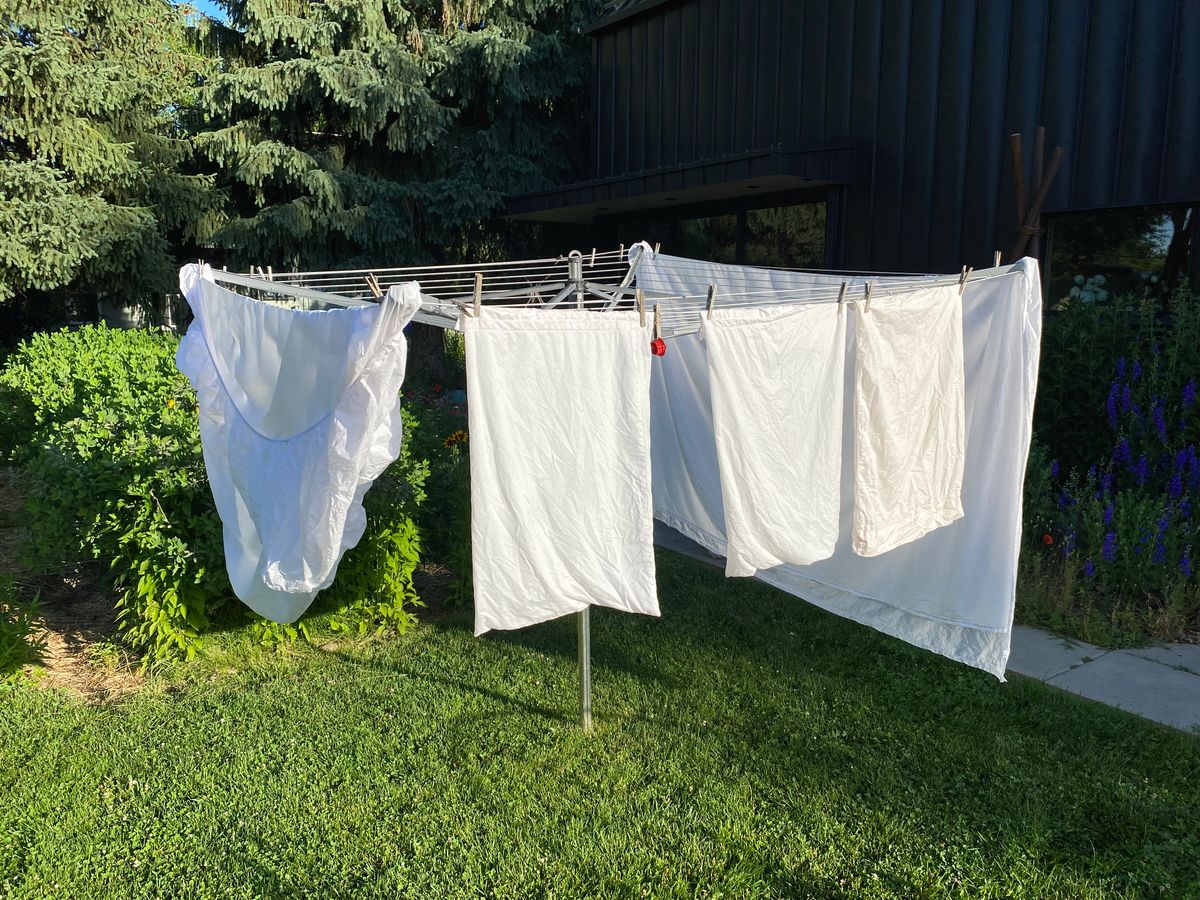Hung Out to Dry

Why yes, I'm glad you asked – those ARE my bed sheets hanging on the clothesline.
I love line-drying my laundry, especially the sheets. Mostly, because of the way they smell, which is pretty magical. Nothing else in the world like it – and no chemicals involved. (If you're interested in the scent science of why, check out this article from the New York Times.) They feel pretty amazing to the touch, as if they've been starched by the sun and wind, and those same solar rays can kill bacteria. Sheets dried on the clothesline are also rumored to promote good sleep, and if you have a clothesline like mine that moves, they can transform your laundry into a mobile, a kinetic work of art on a breezy day.
Here's another reason I love using a clothesline: It's a small act of rebellion against the machine. Every time I fasten a pillow case to the line with a wooden clothespin, I think about the energy I'm not using. Yes, there are minor cost savings to be reaped, which never hurts, but mostly I get a thrill from my alliance with the sun and wind to off-grid my laundry and diminish carbon emissions by skipping a drying cycle. (Clothes dryers in the U.S. create 40 million metric tons of carbon dioxide emissions each year; electric clothes dryers consume as much electricity as the state of Massachusetts uses in a year – and that's not even considering clothes dryers that run on natural gas.)
Okay, sure, I've got an electric clothes dryer! And it comes in pretty handy for a good chunk of the year. As well, I understand that many people don't have the outdoor space to install a clothesline or that some private communities have banned them. But the clothesline, oh the clothesline! Can you imagine the energy savings and the enhancement to life if we all used one? If you need more incentive than I've provided, check out the Top-10 Reasons to from Project Laundry List.
Now my question for you, dear reader: So what's your minor act of environmental rebellion going to be this summer?
Speaking of summer: Next Tuesday is July 4 🇺🇸🌭🧨 so we'll be taking the day off to chase grandkids, grill something delicious, and manage the pop-bang-crack fireworks anxiety of our dogs. We'll see you with another edition of the newsletter the following week.
Godspeed, friends.
Russ
Cool Tools
- It's Not Just for B Corps - Did you know the B Impact Assessment is free to use whether you pursue B Corp certification or not? It's a great way to holistically look at your company's impact and benchmark against others. Nearly a quarter-million companies have registered to use it, which far outpaces the 7,019 companies that are certified B Corps as of this moment.
Trivia Time
Okay, let's keep hanging laundry here, folks. The average mature tree absorbs about 50 pounds of CO2 in a year. How many mature trees would it require to offset the CO2 emissions generated by one household using an electric clothes dryer over the course of a year?
- 17
- 25
- 46
- 98
Today's trivia answer can be found at the bottom of this newsletter.
Find the Most Meaningful Work of Your Career
Our partner One Work has you covered with meaningful work that goes beyond a paycheck, a cubicle, or a weekly team Zoom call. In this week's "Destigmatized" edition, you'll find purposeful jobs like those below, along with many more at the One Work website.
• OLLY- A public benefit corporation, Olly specializes in plant-powered supplements and partners with the JED Foundation to foster mental health. VP Brand Strategy, San Francisco, CA.
• AMY'S - A pioneer in natural organic foods and a certified B Corp, Amy's has one perk that really stands out: It offers onsite, affordable health care centers at its plants. People Business Manager, Pocatello, ID.
• ABOVE GREEN - A consultancy that specializes in sustainable building certifications and emphasizes professional development for the people who work there. Sustainability Consultant, REMOTE.
Check out One Work's full roster of purposeful jobs with mission-driven companies and organizations.
Trivia Answer
It would take approximately 46 mature trees to offset one household's CO2 emissions from drying its clothes using electricity. (Remember, significant electricity is generated in this country using coal.) Zoom out to a macro view and it would require a forest of 4.8 billion trees to offset the CO2 generated by all the households in the U.S. using clothes dryers. Assuming that a forest has 500 trees per acre, that's about 9.6 million acres or roughly the size of the state of Maryland.
Have an interesting social impact tool, idea, or trivia question you'd like to share? Reply to this newsletter and let me know - I'd love to hear about it. You can also hit me up at rstoddard@oliverrussell.com.
Also - please don't hesitate to forward this to a friend you think would benefit from it - thank you!
